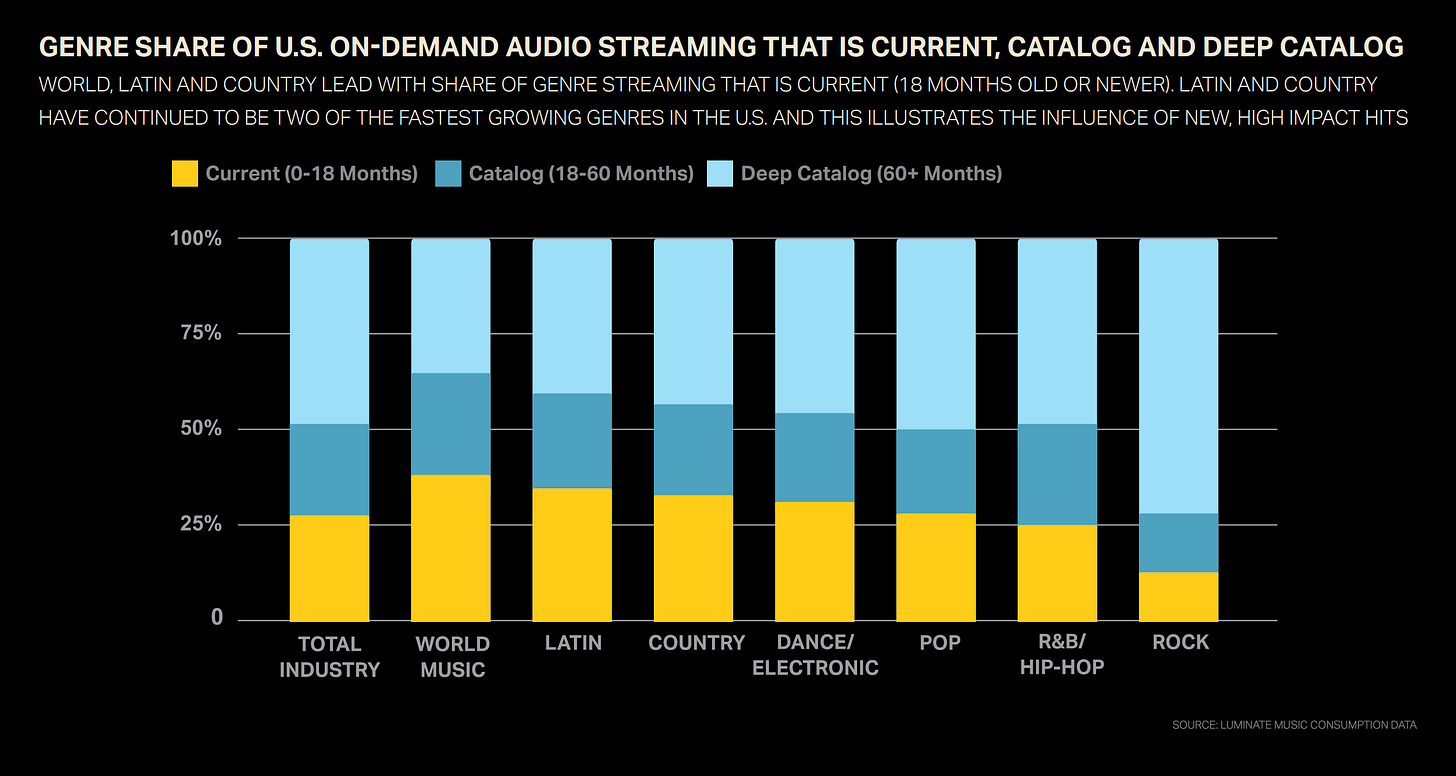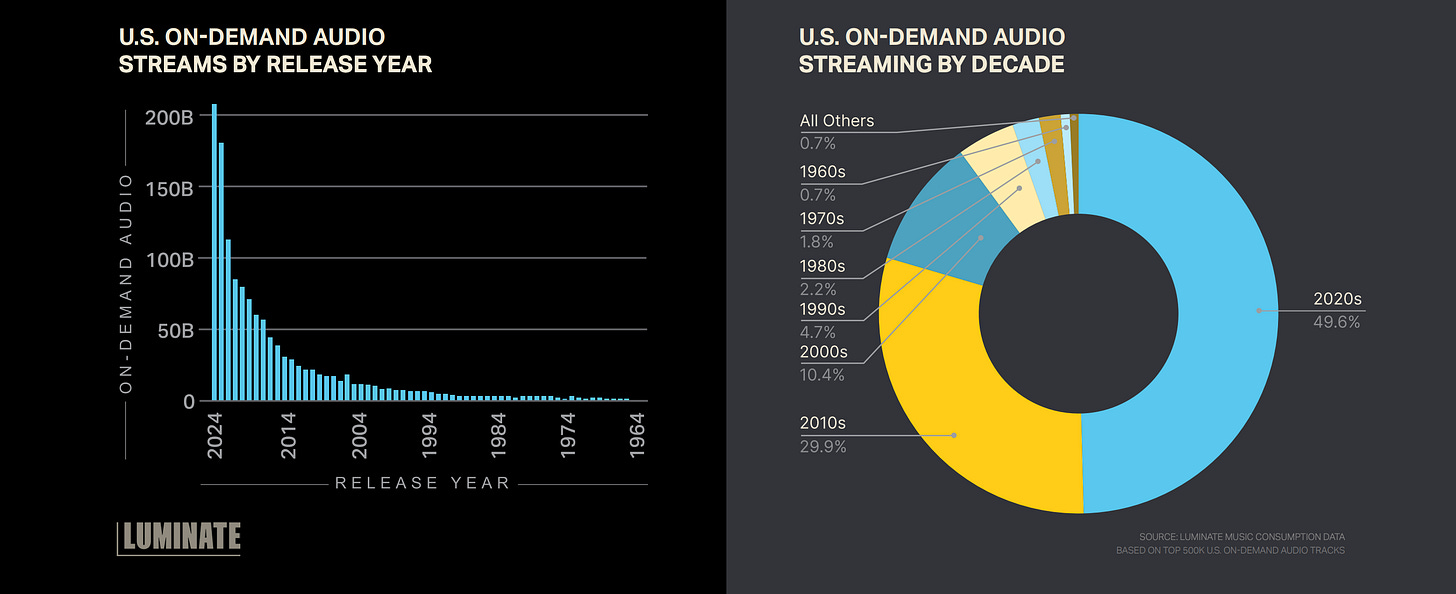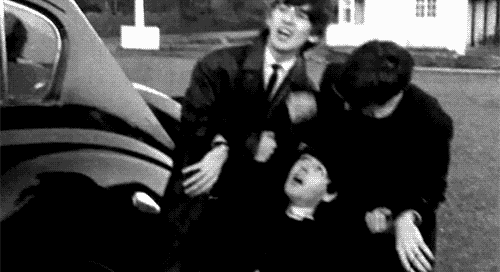
Howdy! If you’re a subscriber, welcome back. If you’re new, I’m happy to have you here at Can’t Get Much Higher, a newsletter about the intersection of music of music and data. This week we’re talking about if music from decades ago is crowding out hits from the latest artists.
TikTok can sometimes collapse time in on itself. You could be Fleetwood Mac. You haven’t had a hit in decades. Then some guy posts a TikTok of himself skateboarding to your 1977 song “Dreams,” and suddenly it’s in the Billboard top 20 again, competing with the likes of Harry Styles and Drake for the ears of listeners.
 Tiktok failed to load.
Tiktok failed to load.Enable 3rd party cookies or use another browser
On the surface, this isn’t that crazy. Songs go viral on TikTok all the time. But “Dreams” is really old. Again, it was first released in 1977. Its TikTok-led resurgence happened 43 years later. The equivalent to that would be if a recording from 1934 was a hit when “Dreams” came out. That’s not something that happened in 1977. Nearly everything on the charts was from the last couple of months. What’s interesting — and possibly problematic — is the success of a very old song seems to be common these days.
Above you can see a graphic from Luminate, the company that aggregates data for Billboard. It breaks down how old the songs were that people listened to in 2024. What we see is that nearly 50% of song plays were for music that was at least five years old. And this skew is even worse for other genres. For example, nearly 75% of rock music that people listened to in 2024 was at least five years old.
This seems like a huge problem. Not only does it signify culture being stuck, but it means that it will be harder than ever for young artists to have a career if streaming services and labels give priority to the older songs that people want to hear. Luckily, this isn’t the full story.
Elsewhere in their report, Luminate provides additional insight on these trends. Yes, 50% of streams in 2024 came from music that was at least five years old, but it’s not like all of those streams were from music originally released in the 1960s. In fact, half of those old songs being streamed were released in the 2010s. A song from 1977 getting streamed a bunch, like “Dreams,” was a true outlier. Only 1.8% of total streams in 2024 were for music released in the 1970s. In fact, nearly 80% of all streams came from music released after 2010.
True. That doesn’t seem as troubling. But if Luminate ran this report in 1977, would 1.8% of plays be on music from the 1930s? I doubt it. 1.8% is small, but it still might represent a music culture that is out of new ideas. Again, I don’t think this is the case. If you listen to “June in January,” the biggest hit of 1934, you’ll understand why.
Between 1934 and 1977, there were huge improvements in the fidelity of recorded music. The slight hiss in the background of “June in January” suggests that it might as well have been recorded in a different century when compared to the pristine sound of “Dreams.” That’s not to say that “June in January” is bad. But there is a notable difference in the quality of the recording.
Compare “Dreams” to the “Mood,” the song that was at number one when “Dreams” resurged in 2020. While the song “Mood” is as different from “Dreams” as “Dreams” is from “June in January,” the actually fidelity of the audio hasn’t changed that much. Most hits since the expansion of multitrack recording are going to sound pretty pristine.
There are many worrying trends in popular music. Just a few weeks ago, the streaming service Deezer said that they were seeing 10,000 AI-generated tracks uploaded every day. But I don’t think you should be worried about listeners turning their backs on new sounds for hits of yesteryear. Streaming does make those older songs more accessible than ever before, but listeners are still keen to find the hottest new sounds.
A New One
"Sally, When the Wine Runs Out" by ROLE MODEL
2025 - Indie Country
TikTok brought “Dreams” back decades later. It also brought “Sally, When the Wine Runs Out” to the ears of listeners just a few weeks ago. Performed by the indie country artist ROLE MODEL, “Sally, When the Wine Runs Out” is one of those songs that will hook you in a matter of seconds. For me, it’s the single second where the chorus starts. It just feels too good.
An Old One
"Transfusion" Nervous Norvus
1956 - Novelty
One of the strangest music trends of the 20th century was when songs about people dying would become popular hits with some regularity. Because of the oddness of this trend, I’ve always been fascinated by it. A few weeks ago, my fascination brought me to “Transfusion,” one of the strangest songs in the death disc tradition. The song follows a man who gets in a car crash, swears he’ll never speed again, but then does after getting a blood transfusion. The song was so bizarre and reckless that radio stations refused to play it.
Shout out to the paid subscribers who allow this newsletter to exist. Along with getting access to our entire archive, subscribers unlock biweekly interviews with people driving the music industry, monthly round-ups of the most important stories in music, and priority when submitting questions for our mailbag. Consider becoming a paid subscriber today!
Recent Paid Subscriber Interviews: Pitchfork’s Editor-in-Chief • Classical Pianist • Spotify’s Former Data Guru • Music Supervisor • John Legend Collaborator • Wedding DJ • What It’s Like to Go Viral • Adele Collaborator
Recent Newsletters: Personalized Lies • The Lostwave Story • Blockbuster Nostalgia • Weird Band Names • Recorded Music is a Hoax • A Frank Sinatra Mystery • The 40-Year Test
Want to hear the music that I make? Check out my latest single “Overloving” wherever you stream music.



















The labels and radio corporations have been crowding out new music with old stuff they already own since the late 1980s. We had to start a whole new "alternative" music industry then to get out from under their suffocating "Classic Rock" blockade; but then they bought that industry out too.
Nostalgia is now a weapon the past wields against the present and future; + a tool of devious marketing.
Never trust corporate appeals to it.
Nervous Norvus lived for many years on Grand Avenue near Downtown Oakland. A true icon!